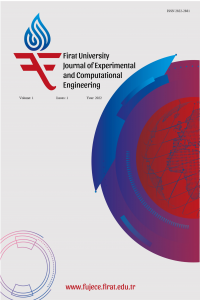DCGAN ile üretilen sentetik görüntülerin veri boyutuna ve epoch sayısına göre incelenmesi
Son yıllarda Bilgisayarla Görü için yapılan çalışmalarda Çekişmeli Ağlar’ın popülerliği artmıştır. Yapılan çalışmalarda kullanılan verilerin yetersiz oluşu ve bunun sonucunda oluşturulan modelin iyi eğitilememesi veri arttırma ve sentetik veri üretme gibi tekniklere dikkat çekmektedir. Bu makalede yapılan çalışmada Çekişmeli Üretici Ağlar (GANs) kullanılarak sentetik veri üretimi yapılmıştır. Kullanılan veri setindeki veriler çevrimiçi olarak bulunan CelebA veri setinden alınan 10000 yüz görüntüsünden oluşmaktadır. Veri sayısındaki artışın GANs çeşitlerinden biri olan DCGAN tarafından oluşturulan sahte görüntüler üzerindeki etkisi makalenin ana konusudur. Yapılan çalışmada veriler ikiye ayrılarak kullanılmıştır. İlk yapılan çalışmada 5000 veri, sonraki çalışmada ise 10000 verinin tamamı kullanılarak sahte yüz görüntüleri oluşmuştur. Alınan sonuçta ise veri sayısının ve epoch sayısının artışının oluşturulan sahte görüntülerin başarısıyla doğru orantılı olduğu görülmüştür.
Anahtar Kelimeler:
Çekişmeli üretici ağlar, Sentetik veri, Üretici model
An examination of synthetic images produced with DCGAN according to the size of data and epoch
In recent years, the popular network of adversarial networks has increased in studies for computer vision. The lack of data used in the studies and the lack of good training for the resulting model draw attention to techniques such as data enhancement and synthetic data generation. In this article, synthetic data was produced using Generative Adversarial Networks (GANs). The data in the dataset used consists of 10000 faces from the CelebA dataset available online. The impact of the increase in the number of data on fake images created by DCGAN, one of the GANs, is the main topic of the article. In the study, the data is divided into two parts. In the first study, fake data were generated from 5000 data, and in the next study, fake data images were forged using all of the data meaning 10000 data. The result was found that the number of data and the increase in epoch were accurately proportional to the success of the fraudulent images created.
Keywords:
Generative adversarial networks, Synthetic data, Generative model Çekişmeli üretici ağlar, Sentetik veri, Üretici model,
___
- [1] Sim E-A, Lee S, Oh J, Lee J. “Gans and dcgans for generation of topology optimization validation curve through clustering analysis”. Advances in Engineering Software, 152, 102957, 2021.
- [2] Goodfellow I. Pouget-Abadie J, Mirza J, Xu M, Warde-Farley B, Ozai D, Courville S, Bengio, Y. “Generative adversarial networks”. Curran Associates, Inc., 27, 2014.
- [3] Zhang H, Xu T, Li H, Zhang S, Wang, X, Huang X, Metaxas D. “Stackgan: Text to photo-realistic image synthesis with stacked generative adversarial networks”. Institute of Electrical and Electronics Engineers Inc., 5908-5916, 2017.
- [4] Zhu J.-Y, Park T, Isola P, Efros AA. “Unpaired image-to-image translation using cycle-consistent adversarial networks”. IEEE International Conference on Computer Vision (ICCV), 2242-2251, 2017.
- [5] Antipov G, Baccouche M, Dugelay J.-L. “Face aging with conditional generative adversarial networks”. IEEE Conference on Image Processing (ICIP), 2089-2093, 2017.
- [6] Radford A, Metz L, Chintala S. “Unsupervised representation learning with deep convolutional generative Adversarial Networks”. CoRR, 1511, 06434, 2015.
- [7] Chen X, Duan Y, Houthooft R, Schulman J, Sutskever I, Abbeel P. “Infogan: Interpretable representation learning by information maximizing generative adversarial nets”. Advanced in Neural Information Processing Systems, 2016.
- [8] Denton E, Chintala S, Szlam A, Fergus R. “Deep generative image models using a Laplacian pyramid of adversarial networks”, Advanced in Neural Information Processing Systems, 28, 2015.
- [9] Ledig C, Theis L, Huszár F, Caballero J, Cunningham A, Acosta A, Shi W. “Photo-realistic single image super-resolution using a generative adversarial network”, IEEE Conference on Vision and Pattern Recognition (CVPR), 105-114, 2014.
- [10] Luo X, He X, Chen X, Qing L, Zhang J. “DualG-Gan, a dual-channel generator based generative adversarial network for text-to-face synthesis”, Neural Networks, 155, 155-167, 2022.
- [11] Kaggle. CelebFaces Attributes (CelebA) Dataset. https://www.kaggle.com/datasets/jessicali9530/celeba-dataset (01.09.2022).
- [12] Çelik G, Talu MF. “Çekişmeli üretken ağ modellerinin görüntü üretme performanslarının incelenmesi”. Balıkesir Üniversitesi Fen Bilimleri Enstitüsü Dergisi, 22, 181-192, 2020.
- [13] Shahriar S. “Gan Computers Generate Arts? A survey on visual arts, music, and literary text generation using generative Adversarial Network”. Displays, 73, 102237, 2022.
- Başlangıç: 2022
- Yayıncı: Fırat Üniversitesi
